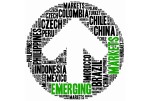MUFG: No tantrums for major emerging markets, just tears for frontier markets
MUFG: No tantrums for major emerging markets, just tears for frontier markets

EM assets have bounced off recent lows – a mirror image of the USD index and US 10 year rates coming off recent highs – yet the forward path remains uncertain with global markets still apprehensive about EM balances in a world of elevated interest rates and a strong USD. With intensifying concerns surrounding EM debt balances, we recently catalogued a fundamental difference between major EMs (that are systemically more important), and smaller frontier markets.
Our bottom-up analysis of more than 50 EMs to identify those most susceptible to pressure and outright default, signals that a host of frontier markets are screening as vulnerable, namely, El Salvador, Ghana, Tunisia and Pakistan. COVID has pushed several issuers into defaults/restructurings, and the credit spreads of other vulnerable frontiers have widened significantly (in tandem with the stronger USD). In contrast, the largest EMs have limited near-term USD debt obligations relative to FX reserves.
FX views
With the EM complex broadly pro-cyclical in nature, EM FX is not out of danger as long as we remain in a global down-cycle. Downside risks to growth have intensified and we highlighted in our recent FX monthly that downside risks to growth in Europe have risen after Russia continued to cut the supply of natural gas, which reinforces the risk of a protracted recession in Europe heading into the more challenging winter period). We believe this will keep risks titled to the downside for EUR/USD which we see falling back below parity in the near-term. Within EM EMEA, we stay constructive on PLN and HUF and retain our cautious stance on the CZK in view of differentiation in monetary policies.
Trading views
In spite of a very strong NFPs as well as heightened geopolitical tensions around Taiwan peninsula, EM FX overall has been stable on the week. This calmness may simply be illusory ahead of CPI or could just be indication of summer markets. A third option is that it is getting harder and harder for USD to go higher. Any of these things are possible and with flows a lot lighter than usual it is difficult to be confident of the answer.
Week in review
Saudi Arabia’s quarterly fiscal figures continued to break new records (USD20.8bn in Q2 2022; ~8.8% of GDP) on firmer energy prices. The Czech Republic turned more dovish with the CNB keeping rates unchanged at 7.0% but we believe we are not yet done on rates. Inflation in Turkey hit 80% y/y in July but the peak is likely north of 90% y/y by October. Finally, regional PMI prints for July signalled a weak backdrop with the outlook even more uncertain given recessionary risks.
Week ahead and calendar
This week, we expect Wednesday's US CPI to be the main focus in global markets, especially after the much stronger-than-expected July NFP print. For emerging markets, we have a host of inflation prints for July – Egypt (MUFG: 13.2% y/y; no consensus), Czech Republic (MUFG: 18.6% y/y; consensus 17.8% y/y), Hungary (MUFG: 13.5% y/y; consensus 13.0% y/y) and Russia (MUFG:15.0% y/y; consensus 15.3% y/y).
Forecasts at a glance
Headwinds facing EMs are getting stronger as persistently high inflation prompts more hawkish monetary policy responses leading to further tightening of financial conditions and more sacrifices from growth.
Core indicators
EM securities suffered a record breaking fifth consecutive outflow (USD-9.8bn) in July, with mounting recession risks, a hawkish Fed and stronger USD all weighing on investor sentiment. Looking ahead, key factors influencing flows will be the timing of inflation peaking and the Chinese outlook. Other core factors for the outlook will be the market appetite for new issuance of external debt. Net issuance has also gone negative in recent months and – looking at regions – remains positive only for large oil exporters in the Middle East.








